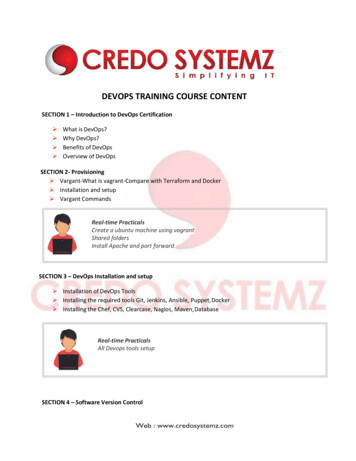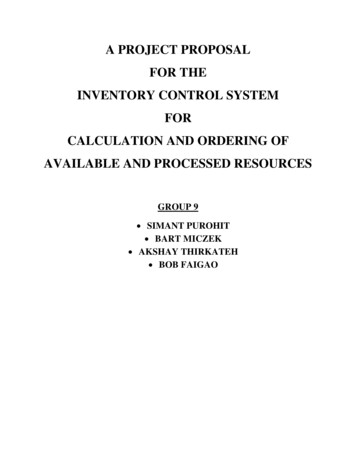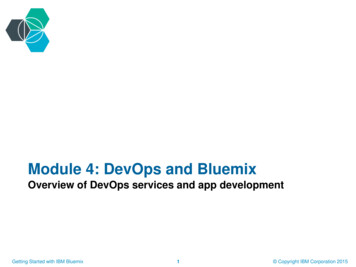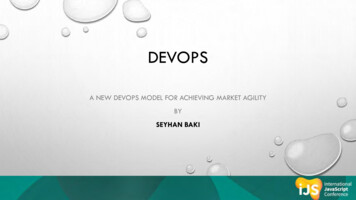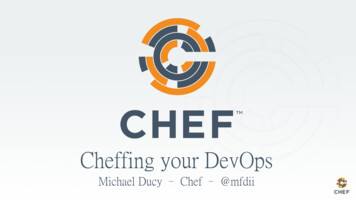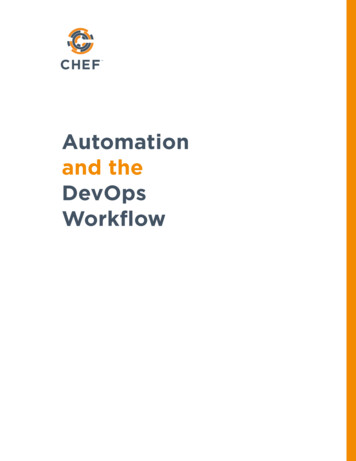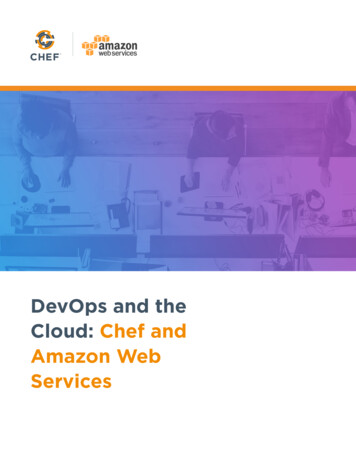
Transcription
DevOps and theCloud: Chef andAmazon WebServices
Copyright 2017 Chef Software, inc.http://www.chef.io 2017, Amazon Web Services, Inc. or its affiliates.All rights reserved.2 of 25
Table of ContentsIntroduction. 4What Is DevOps?. 5DevOps Solutions. 9What Is Chef Automate?. 11Examples of Using Chef with AWS. 14Getting Chef Automate on the AWS Marketplace. 16Provisioning AWS with Chef. 17Using AWS CloudFormation with Chef. 18Learn Chef Tutorials. 18Automated Testing and DevOps. 19Case Study: Gannett. 20Key Points. 22Resources. 23About. 253 of 25
IntroductionThis paper is an introduction to how using DevOps patterns withAmazon Web Services (AWS) can decrease time to market andreduce costs. The paper first discusses DevOps, which is a cultural andtechnical movement. With DevOps, companies can deliver value to theircustomers quickly and safely.The second section presents common problems many enterprisesencounter and the solutions DevOps offers for these problems. Somestatistics demonstrate how and why DevOps makes financial sense.The third section contains some examples of how to use automation, thetechnology that is fundamental to a DevOps workflow, to provision andmanage resources. The examples use Chef for automation and AWS asthe cloud provider.Finally, there is a case study that shows how Gannett used AWS andChef to transform their culture, processes and tools.4 of 25
What Is DevOps?DevOps is a cultural and technical movement that focuses on buildingand operating high-velocity organizations. DevOps began with webinnovators who needed to operate at massive speed and scale. It cameinto existence at the same time as cloud technologies, which make itpossible to allocate resources quickly and inexpensively. TraditionalIT practices were not designed for the flexibility and speed the cloudoffers, and as a result development and deployment practices needed tobe reimagined. We call this new way of working DevOps.DevOps Cultural ValuesDevOps advocates cultural values that encourage communication andcooperation. The term “DevOps” is a combination of “Development”and “Operations” and signifies a close relationship between those twoareas of expertise. In many traditional enterprises, these groups areseparate. The developers create applications and the operations teamsdeploy them to an infrastructure they manage.The term “DevOps” is a combination of Often, development and operations are inseparate silos. Silos exist when organizations“Development” and “Operations” and have strict divisions of responsibility. Often,signifies a close relationship between communication between groups only occursthose two areas of expertise. through a formal mechanism, such as aticketing system.While it might seem more efficient to have different groups, each with awell-defined specialty, silos require handoffs from one group to another.Handoffs introduce significant delays and inaccuracies. For example, incompanies with silos, it often takes multiple groups to configure a fullstack. One group writes the specifications, a second group configuresthe VM, that group hands the VM off to a third group to install thedatabase, and so on. Each handoff means another delay.Handoffs also introduce inconsistencies and inaccuracies. InImplementing Lean Software Development: From Concept to Cash,Mary and Tom Poppendieck conservatively estimate that each handoffleaves behind approximately 50% of the knowledge that’s meant to betransferred. This means that there is: 25% of the knowledge left after two handoffs. 12% of the knowledge left after three handoffs. 6% of the knowledge left after four handoffs. 3% of the knowledge left after five handoffs.5 of 25
The costs of handoffs negatively offset the benefits of the cloud’s abilityto flexibly deliver compute resources. In fact, safely reducing the numberof handoffs is one of the primary benefits of the DevOps workflow.It’s common for each silo to have its own procedures and tools. Lack ofa common approach contributes to the problems of long build timesand errors.In contrast, companies that have adopted DevOps often use small teamsthat work together to create applications and to provision and managethe infrastructure that these applications use. In his article, “How EtsyMakes DevOps Work,” John Dix interviewed Michael Rembetsy, VP ofTechnical Operations at Etsy, who explained how DevOps evolved at hiscompany. Rembetsy gave an example of how teams work:“If we have a search team, we don’t have a dedicated operationsperson who only works on search. We have a designated person whowill show up for their meetings, will be involved in the development ofa new feature that’s launching. They will be injecting themselves intoeverything the engineering team will do as early as possible in order tobring the mindset of, ‘“Hey, what happens if that fails to this third-partyprovider? Oh, yeah. Well, that’s going to throw an exception. Oh, OK.Are we capturing it? Are we displaying a friendly error for an end user tosee? Etc.’”Working together on all aspects of a feature eliminates handoffs andproblems that come from poor communication and silos. Consensus iseasier to achieve, and everyone understands design decisions, whetherthey are for the application or the infrastructure. Quick decisionstranslate into companies that move at higher velocity.DevOps Technical ValuesCompanies that practice DevOps have workflows designed for highvelocity. Software moves quickly from development to testing, stagingand then to production. Environments, often located in the cloud, arequickly provisioned and configured and are consistent with each other.Software is promoted from one phase of the pipeline to another eitherautomatically or with a straightforward manual step.To avoid lengthy development times and difficult releases, companiesthat use DevOps release software iteratively. They begin with a minimumviable product, gather customer feedback, improve the product, andrelease the software again. The product evolves over multiple cycles.Because each new version of the product has only a few changes, eachiteration is easier to debug.6 of 25
Automation for DevOpsThere are a variety of technologies that enable a DevOps workflowbut the primary one is automation. In fact, automation underlies allthe patterns and practices that constitute DevOps. One aspect of anautomation platform is that it gives you the ability to describe yourinfrastructure as code. When infrastructure is code, you can: Eliminate error-prone, time-consuming manual tasks. Standardize development, test and production environments. Build automated release pipelines. Improve cooperation between development and operations.You can treat your infrastructure code just as you would yourapplication code. The code is versionable, testable and repeatable.You can (and should) use the same deployment pipeline for yourinfrastructure as you do for your applications.“The tools we use reinforce thebehavior; the behavior reinforcesthe tool, thus if you want to changeyour behavior, change your tools.”- Adam Jacob, CTO, ChefBecause automation turns your infrastructure intocode, you can use automated tests. You can buildcompliance and security tests into the deploymentpipeline, thus catching problems earlier rather thanlater. Instead of making changes whose effects areunknown to your production environment, you canensure that new configurations are safe and stable.By its nature, automation discourages silos. To take fulladvantage of the cloud, you use automation to quicklyspin up resources and configure the entire stack. Scale up, down orhorizontally by running a program that provisions and configures yournetwork in minutes, not weeks. Because the process is automated, youknow the results will be consistent from one run to the next. Everyoneon the team uses the same process to spin up a stack. There are none ofthe handoffs or conflicting procedures that cause delays and errors.7 of 25
AAnother advantage to automation is that infrastructure codeis expressed as human-readable text files. DevOps encouragestransparency. Describing your infrastructure as code means that it isaccessible and readable to everyone on the team. In addition, you cankeep these files in a source control system, where they are versionedand kept safe. All of the advantages of using a source control systemwith your application code apply equally to your infrastructure code.Examining differences between versions of your configuration recipesshows exactly what has changed since the previous known stable stateof the system. Such visibility is critically important.DEV OPSOMATIONUTbegins withINFRASTRUCTUREAS CODEneedsAS CODEcreate infrastructure ion infrastructure codetest automaticallyIDEAVA L U EManual processesWeeks to set up new systems of softwareLegacy systems and toolsInflexible, hard-to-change hardware and softwareOrganizational silosUnwieldly divisions of responsibilityInfrequest, large releasesFear of deployment due to risk to SLAsRegulatory burdensCompliance bottleneck at the end of a project8 of 25
DevOps SolutionsLarge enterprises have many challenges that can be addressed withDevOps. The following figure shows the most pervasive obstacles thattraditional IT practices create when moving from an idea to realizedbusiness value.The next figure shows how cloud-based DevOps practices and toolseliminate these obstacles.9 of 25
Moving away from traditional processes to a DevOps workflow hasdramatic effects on a business. Dr. Nicole Forsgren gave a talk entitled“DevOps and the Bottom Line” at DevOps Enterprise Summit 2014,where she discussed the results of research she has done on theconsequences of practicing DevOps. Her research shows that companiesthat use DevOps have greater agility and reliability as well as bettergrowth and profitability. Here is a summary of these results:DevOps Benefit 1: Improved AgilityCompanies that practice DevOps have 30 times faster deployments and8,000 times faster lead times than their peers. (Lead time is the totaltime, from start to finish, that it takes to develop a product or serviceand deliver it to customers.) Two of the reasons for greater agility are: Infrastructure, runtime environments, and applications are deliveredusing a unified process. The number of handoffs and service tickets is greatly reduced.DevOps Benefit 2: Improved ReliabilityCompanies that practice DevOps have twice the change success rateand 12 times faster mean time-to-recover than peers that do not useDevOps. Some of the reasons for greater reliability are: Integration of compliance and security into the developmentprocess removes blockers. Testing catches problems prior to deployment. Shipping frequency improves with smaller batch sizes. Development environments can closely resemble productionenvironments. Discrepancies between environments is a commonreason for software that works in development but fails inproduction.DevOps Benefit 3: Better Growth and ProfitabilityCompanies that practice DevOps are twice as likely to exceedprofitability, market share and product goals. They exhibit a 50% marketcap growth over 3 years.10 of 25
What Is Chef Automate?Chef Automate gives you everything you need to build, deploy andmanage your applications and infrastructure at speed.Collaborate. Chef Automate provides a pipeline for the continuousdeployment of infrastructure and applications. Chef Automate alsoincludes tools for local development and can integrate with a variety ofthird-party products for developer workflows.Build. Use Chef Automate and its continuous integration anddeployment workflow to test and approve code changes across all levelsof the stack, then package and publish them to a repository.Deploy. With Chef Automate, you will provision and updateenvironments quickly and prevent configuration drift.Manage. Use Chef Automate to make your security and compliancerequirements a part of an automated workflow. When compliance iscode you can find problems early in the development.Chef Automate includes three open source engines: Chef, Habitat andInSpec. Habitat is automation that travels with the application. InSpeclets you verify that pieces of your infrastructure, such as AWS servicesand resources, are configured in accordance with your organization’scompliance and security policies.11 of 25
The third open source engine, Chef, allows you describe yourinfrastructure as code, which means it’s versionable, human-readable,and testable. Use Chef to manage AWS resources and services such asEC2 instances, Security Groups, Elastic Load Balancers (ELB), ElasticBlock Storage Volumes, Route 53, relational databases (RDS) and more.You can take advantage of cookbooks provided by the Chef community,which contain code for managing AWS resources.Understanding ChefAny machine managed by Chef is called a node. A node can be physical,virtual, in the cloud, or even a container instance.A Chef resource describes some piece of infrastructure, such as a file,a template, or a package. A Chef recipe is a file that groups relatedresources, such as everything you need to configure a web server,database server, or a load balancer. Recipes are developed on localworkstations and stored in version control system. Collections of recipesare called cookbooks.Chef uses a client/server architecture to manage the nodes in yournetwork. The Chef client is installed on every node and periodicallypolls the Chef server for the latest recipes. The Chef client runs therecipes and brings the node to the correct state, over time. Chef clientsalso notify the server of their state and can query for the state of othernodes. Because most of the work happens on the nodes, the Chefserver never becomes a bottleneck and you can scale up to manageinfrastructures of any size and complexity.12 of 25
When the Chef client runs, it only updates the node if a change isnecessary. For example, if you have a recipe that installs a packageon a server, Chef only performs the action if the package isn’t alreadyinstalled. If it’s already present, Chef does nothing. This approach, calledtest and repair, coupled with periodic runs of the Chef client has thesebenefits: It eliminates configuration drift over time It handles errors, and network failures by dynamically changingnetwork topology over time It handles complex configuration interdependencies among nodes.Here is a simple diagram that shows how Chef works.13 of 25
Examples of UsingChef with AWSIn this section, you’ll see two examples of how you can use Chef withAWS. Although these examples are simple, you can use the sameprinciples to automate large, complex infrastructures.Registering with an ELBHere is an example of a recipe that registers the node with an ElasticLoad Balancing (ELB) load balancer named elb qa. To do this, therecipe uses the aws elastic lb resource that’s found in the awscookbook.1# Load your AWS credentials databaginclude recipe ‘aws’aws data bag item(‘aws’, ‘main’)aws elastic lb ‘elb qa’ doaws access key aws[‘aws access key id’]aws secret access key aws[‘aws secret access key’]name ‘elb qa’action :registerendThis code pulls down data bag items to retrieve the keys. A data bag is acollection of key-value pairs that stores configuration state on the Chefserver. In this example, the data bag stores AWS access credentials.You can encrypt data bags to protect sensitive information, such ascertificates, API keys, and ws14 of 25
Managing User AccessHere is an example of using Chef to help manage user access toAWS instances across availability zones and regions. There is a Chefcommunity cookbook called users that solves the problem.2 It lets youstore Linux user data in a data bag, and it automates the process ofmanaging users and their SSH keys.Below is a JSON output for a data bag item that describes the desiredaccount settings for a user named han. Assume that the name of thedata bag itself is users (by default, but the name is configurable).han.json{“id”: “han”,“comment”: “Han Solo”,“home”: “opt/carbonite”,“groups”: [“rebels”, “scoundrels”, “sysadmins”],“ssh keys”: [“AAA123 xyz foo”,“AAA456 uvw bar”]}The users cookbook lets you write recipes that manage account settingsbased on data in the users data bag. For example, this recipe ensuresthat the rebels group exists and that it includes the correct useraccounts, based on the data bag.users manage ‘rebels’ dogroup id 1138action [:create]endThe users manage resource leverages the user, group, directory, andtemplate resources to ensure that the group rebels is created on thenode that is being configured; that the group rebels is set to gid 1138;that the group has the correct set of users (including user han); and thatany SSH keys associated with those users are rs15 of 25
Other ExamplesThere are many other cookbooks that can help you manage your AWSenvironment: The AWS Route 53 cookbook at https://supermarket.chef.io/cookbooks/route53 helps you manage the AWS Route 53 DNSservice. The AWS Security cookbook at https://supermarket.chef.io/cookbooks/aws security helps you manage AWS security groupsand rules. The Amazon Relational Database Service (Amazon RDS)cookbook at https://supermarket.chef.io/cookbooks/aws-rds helpsyou manage Amazon RDS.Getting Chef Automate on the AWSMarketplaceThere are three ways to get Chef Automate in an AWS environment toautomate large, complex infrastructures.AWS OpsWorks for Chef AutomateAWS OpsWorks for Chef Automate gives you all the features of ChefAutomate and Chef server as a managed service in Amazon ElasticCompute Cloud (Amazon EC2). You can: Deploy in 10 minutes or less, directly from the AWS Console. All youneed is an AWS account. Receive the equivalent of 10 nodes free per month to get youstarted. Additional usage is billed by the hour, based on the numberof nodes under management. You pay only for the nodes you use,for the hour you use them. Take advantage of automatic backup/restore and softwareupgrades provided by AWS.With AWS OpsWorks for Chef Automate, the resources that run yourChef environment remain fully under your control so you still have theflexibility to use Chef however you want. You no longer need to worryabout setting up and maintaining your Chef environment. You can getit up and running in just a few clicks from the AWS OpsWorks Console.OpsWorks reduces the time you’ll spend deploying and managing yourChef environment, letting your team focus on their core automation tasks.16 of 25
Chef Automate in the AWS MarketplaceGet all the benefits of Chef Automate in an easy to deploy model thatlets you manage your upgrade and back-up strategy.Self-HostingIf you want complete control of your Chef Automate installation, youcan also install Chef Automate on Amazon EC2 instances yourself.Provisioning AWS with ChefChef provisioning lets you create nodes and configure them, includingAmazon EC2 instances. Rather than bringing up individual nodes, youcan use Chef provisioning to describe an entire cluster or fleet. You canbuild your infrastructure as many times as you want in the cloud, onvirtual machines in your data center, or even bare metal.Chef provisioning for AWS includes the most commonly used AWSresources. For example, you can manage Amazon EC2 instances, AmazonVirtual Private Clouds (VPCs), security groups, IAM roles and instanceprofiles. Chef provisioning can also consume IAM roles so that all thecomponents in the stack that have the appropriate IAM profile areprovisioned correctly. You can also manage common AWS services suchas Amazon Relational Database Service (RDS) and Amazon Route 53.You can see a complete list of list of AWS resources at https://docs.chef.io/release/devkit/provisioning aws.html.17 of 25
Using AWS CloudFormationwith ChefAWS CloudFormation is an AWS provisioning service that is based ontemplates. A template is a description of your AWS infrastructure that iswritten in JSON. A basic CloudFormation template includes: Format version. This is the latest version of the template. Description. This lets you know what the template does. Parameters. These let you customize a template with specificvalues, such as a domain name or database password. Resources. These are the smallest pieces of infrastructure that youcan describe, such as a load balancer or an elastic IP address. Outputs. These return values, such as the public name of anAmazon EC2 server.One reason to use AWS CloudFormation is because you want toconfigure AWS resources that aren’t described by Chef provisioning.Often, people use CloudFormation in conjunction with Chef. They usethe templates to set up the AWS infrastructure, the Chef server and thenodes. Then, they use Chef to handle the network and to configure theapplications. Remember that you can also bootstrap your node withCloudFormation.Learn Chef TutorialsA good way to get started exploring how Chef integrates with AWS isto try out the tutorials on Learn Chef. Start with the “Manage a node”tutorial. In this tutorial, you’ll use Chef to configure a node, check that itsconfiguration is up to date, and change that configuration. You can useeither AWS OpsWorks for Chef Automate or Amazon Web Services toset up the Chef server.18 of 25
Automated Testing and DevOpsAutomated testing is a critical part of a DevOps workflow. With it,you can easily collaborate with others to write code and acceptcontributions to your codebase because you can be confident that thecode works before you deploy to production. Automated tests canalso be incorporated into continuous delivery pipelines such as the oneincluded as part of Chef Automate.Using Test Kitchen for Automated TestingTest Kitchen is a tool that runs your infrastructure code in an isolatedenvironment that resembles your production environment. With TestKitchen, you continue to write your Chef code from your workstation,but instead of uploading your code to the Chef server and applying itto a node, Test Kitchen applies your code to a temporary environment,such as a virtual machine on your workstation or an Amazon EC2instance. For the demo, Test Kitchen is automatically installed on theworkstation.To get you started, the demo includes unit tests written with ChefSpecand integration tests written with Serverspec. ChefSpec verifies thatresources are behaving appropriately. Serverspec verifies that yourservers are configured correctly. You can experiment by making changesto the Chef code and then, with Test Kitchen and automated tests, getfast feedback on whether your changes do what you intended.Once you are happy with your tested changes, you can use a differentcookbook, also included in the repo, to automatically deploy the sampleapplication to Amazon EC2 instances that Chef will provision for you,put into different secure subnets and register with an Elastic LoadBalancer (ELB) for redundancy.19 of 25
Case Study: GannettGannett is a national and local newspaper and media company. Itsnational brand is USA Today. It also owns more than 92 media companiesin 33 states, such as the Arizona Republic and the Indianapolis Star.For many years, Gannett’s deployment workflow was characterized bymultiple handoffs and manual testing. Maintaining accurate, repeatablebuilds was difficult. There were many build failures and tests were oftenrun in the wrong environments. Deployment and provisioning times couldrange from a few days to several weeks.There were two operations teams, each in its own silo both physically(i.e. within different data centers) and organizationally. Neither team hadaccess to the cloud or the development environments.“We’ve been abledeployment timesAs a reaction to the situation, a kind of “shadow IT” evolved on thedevelopment side, with developers spinning up Amazon Elastic ComputeCloud (Amazon EC2) instances and using personalHeroku accounts, and then linking these toproduction DNS. However, there was no oversightto reduce applicationover the costs of applications, and security had nofrom weeks using our way to audit the stacks.former on-premises infrastructure to just“It was a situation that had to change,” says ErikBursch, Gannett’s Vice President for Platformas a Service. “Our task is to consistently provide- Erik Bursch, Vice President for Platform as a Service, Gannettcustomers with the fastest and best digitalexperiences possible. Critical to that effort is ourability to react faster. We can’t underestimate the value of speed andconsistency in getting our products to the market.”minutes using AWS and Chef.”Bursch says Gannett recognized the cost and agility benefits of the cloud.He also knew that, with AWS, developers would use standardized toolsand resources and would benefit from AWS’s scalability and its costefficient, compute-on-demand model.20 of 25
When the opportunity arose to rebuild a hybrid architecture on AWSfor a development environment that would mimic production, the teamdecided to use Chef to manage the infrastructure. The improvement wasimmediate. Other developers noticed, and soon discussions turned to thepossibility of automating both Gannett’s development and operationsprocesses using AWS and Chef.The benefits have been impressive. Different teams are working moreclosely together, there is greater visibility for tracking and auditingchanges throughout the environment and, most importantly, applicationsshare a common deployment methodology that can be customized toexpedite application delivery.“We’ve been able to reduce application deployment times from weeksusing our former on-premises infrastructure to just minutes usingAWS and Chef,” says Bursch. “Instead of a single desktop applicationdeployment in a week, like we experienced in the past, we’re nowdeploying an average of 25 per week. That means more timely servicesfor our customers by using the latest digital technologies to build andretain readership.”21 of 25
Key PointsRead the complete storyat tt/Watch the video, USAToday Brings Shadow ITinto the Light at https://www.youtube.com/watch?v goRTQs7oGskThis paper discusses the intersection of DevOps, automation and thecloud. DevOps is a cultural and technical movement that allows companiesto deliver value to their customers quickly and safely. DevOps cultural values emphasize communication and cooperationand discourage handoffs and silos. Companies that have adopted DevOps use small teams that worktogether to create applications and provision and manage the infrastructure that these applications use. Automation is the underlying technology for DevOps. An automation platform should include the ability to describe yourinfrastructure as code. Chef Automate gives you everything you need to build, deploy andmanage your applications and infrastructure at speed. Chef Automate and AWS are tightly integrated. Chef has many resources that are specific to AWS and that allow you to manage yourentire AWS stack. You can use AWS CloudFormation in tandem with Chef to provisionyour network. Together, AWS and Chef Automate can radically speed up deployment times.22 of 25
ResourcesHere is a list of the resources mentioned in this paper along with someothers you might find helpful.Chef permarket.chef.io/cookbooks/aws sChef AutomateChef Automate at https://www.chef.io/automate/Chef at https://www.chef.io/chef/InSpec at https://www.chef.io/inspec/Habitat at https://www.habitat.sh/Chef ToolsChef Development Kit (Chef DK) at https://downloads.chef.io/chef-dk/ChefSpec at https://docs.chef.io/chefspec.htmlServerspec at http://serverspec.org/DevOps and LeanDevOps and the Bottom Line at https://www.youtube.com/watch?v V6DrGBg-w40Dix, John. “How Etsy makes DevOps work” at re/how-etsy-makes-devops-work.htmlNetwork World February 19, 2015.Humble, Jez, et al. Lean Enterprise. Sebastopol: O’Reilly, 2015. Print.Poppendieck, M. and Poppendieck, T. Implementing Lean SoftwareDevelopment: From Concept to Cash. Boston: Addison-Wesley, 2006.Print.Level Up the Change in Your Enterprise—Nordstrom at https://www.youtube.com/watch?v Ot5H2KfWAxIThe Lean Enterprise at https://www.chef.io/webinars/Learning ChefChef web site at https://www.chef.io/Learn Chef web site at https://learn.chef.io/Chef documentation at https://docs.chef.io/List of Chef provisioning resources for AWS at https://docs.chef.io/release/devkit/provisioning aws.htmlChef bootstrapping considerations at https://docs.chef.io/installbootstrap.html23 of 25
AWS ServicesAWS CloudFormation service at st/UserGuide/Welcom
The paper first discusses DevOps, which is a cultural and technical movement. With DevOps, companies can deliver value to their customers quickly and safely. The second section presents common problems many enterprises encounter and the solutions DevOps offers for these problems. Some statistics demonstrate how and why DevOps makes financial sense.


